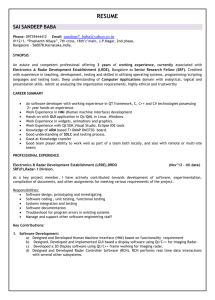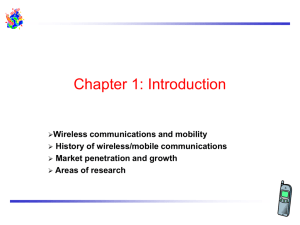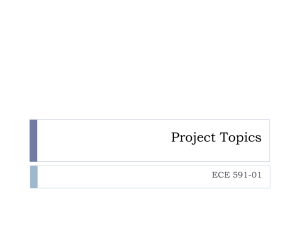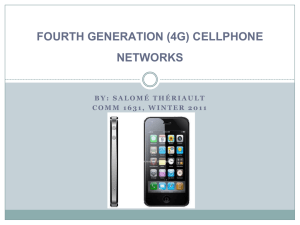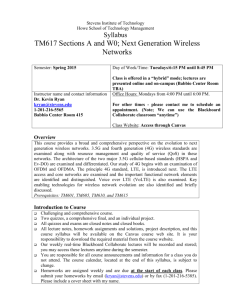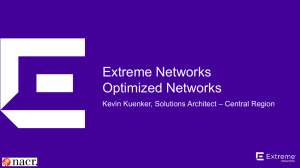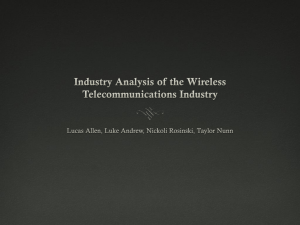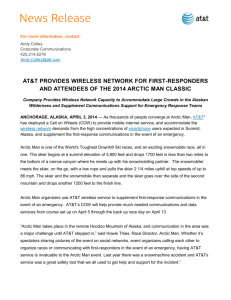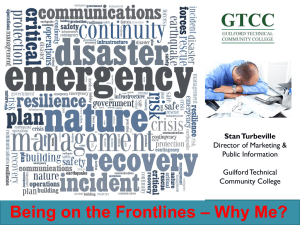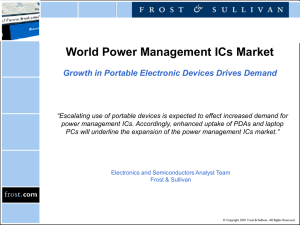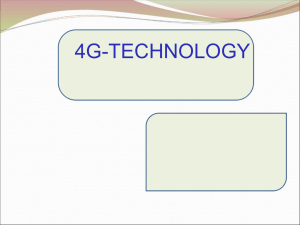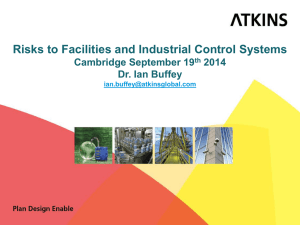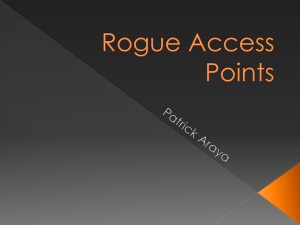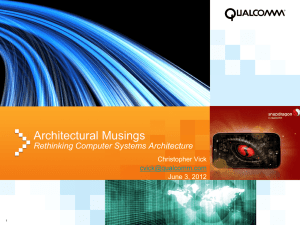Editorial Spotlight - Embedded - High Impact Technology Exchange
advertisement
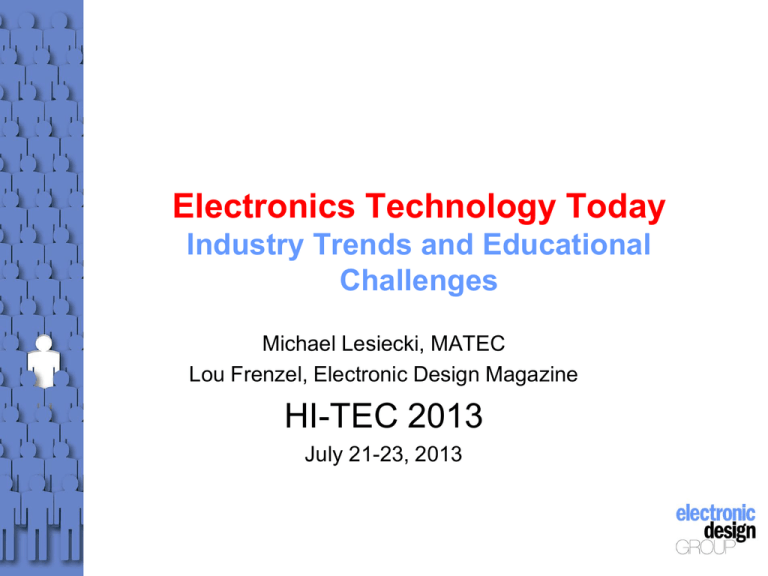
Electronics Technology Today Industry Trends and Educational Challenges Michael Lesiecki, MATEC Lou Frenzel, Electronic Design Magazine HI-TEC 2013 July 21-23, 2013 Dominant Electronic Trends • • • • • • • • Mobile lifestyle Wireless everything Green movement Faster Internet PCs and digital Video Semiconductors Other The Dominant Trend: The Mobile Lifestyle • • • • • • • • • • Smartphones rule Internet access Email Texting Browsing/Search Music Video Shopping Games Apps explosion Related Mobile Trends • The rollout of 4G Long Term Evolution (LTE). • The spectrum shortage issue. – Auctions – White space • Developing the next generation 5G. – LTE Advanced – Millimeter wave (>30 GHz) cells • The small cell movement. The small cell movement • Macrocell coverage inadequate to provide speed and capacity. • Metro, micro, pico, femto cells. DAS. • Wi-Fi offload. • The backhaul issue. • Millimeter wave cells? Other Wireless Trends • Continued Wi-Fi growth • Expanding use of short-range technologies – Bluetooth – ZigBee – Z-Wave – ISM band – RFID – Near Field Communications (NFC) • Industrial wireless • Medical/Fitness applications A major wireless trend: M2M • Increased communication between machines and humans. Machine-to-machine. • Monitor and control from a distance. • Mostly a cellular service. • Connecting anything to the Internet: – The Internet of Things (IoT) – The Internet of Everything Increased Automotive Applications • Electronic monitoring and control of everything. • Infotainment • Telematics • Intel.Trans. Sys. • V2V and V2I • Big issue: Driving distraction The green movement • Alternative energy – Solar – Wind – Electric vehicles • The smart grid, smart meters. • Home area networks • Low power design of ICs and equipment The Internet • • • • • • • • • Still not large enough or fast enough. More and faster fiber optics 40, 100, 400 Gb/s now. 1 Tb/s coming. Optical transport network (OTN) vs. Sonet Carrier Ethernet. Metro nets. Faster data center interconnects. Cloud computing. Software-defined networking (SDN). KEY ISSUE: Security. Computers and digital trends • • • • • • • • • The fading PC. Laptops still viable. The rise of the tablet. Low power vs. speed. Multicore processors. Virtualization. 32-bit embedded controllers. FPGAs replace processors. The rise of flash memory. The video “gorilla” • • • • • • • Video dominates our lives. Big screens getting bigger. Higher resolution (4K) and 3D. Over the top (OTT) services rising. More mobile video Major growth in video surveillance. Behind the scenes games movement. • One more thing never taught in schools. A common theme: Communications • All these trends involve some form of electronic communications (wireless, networking, power line) • We are all active users in some form. • Most growth in electronics is from communications. • The missing element is communications education. • Communications is “basic” electronics. • All electronic curricula should have a communications survey course. Semiconductor trends • • • • • Smaller geometry ICs. (<20 nm) Has the limit been reached? Faster and lower power ICs. More and bigger systems on a chip. Increased use of alternative materials than silicon (GaAs, GaN, SiC, SiGe, InP, InGaAs, others) • MEMS and nanotechnology. • Most growth from communications. Other Interesting Trends • • • • • Robotics Drones Driverless cars LED lighting Wearables, glasses, watches, BAN • 3D printing The Battle to Keep Electronic Technology Education Current • • • • • • • • • • Accelerating changes in technology and applications. More rapid technological obsolescence. Smaller but “larger” ICs. The system as a component. Massive rapid adoption of technology. The Internet phenomenon. Reluctance of students to pursue STEM education. Lots of tech jobs, not enough educated workers. Leisurely pace of curriculum reform. A perpetual skew between education and reality. How are colleges dealing with the technology trends? My view. • • • • Slowly if at all. Tradition continues to rule. Continued circuit vs. system emphasis. What basics are relevant? (Fundamentals vs. modern technology practice). • Little or no communications or video coverage. • Reform and updating must be perpetual. • One good solution: online courses. Critical Issues for Education • Keeping pace with real-world technology. • So much to teach so little time. What to add, what to take out. • Attracting students to the programs. • Escalating tuition and other costs. • Retaining students. • Adapting to student behavior. • Updating laboratories. • Keeping local industry happy. • Continuing education. Critical Educational Issue: Continuing Education • For graduates and professors. • Essential to maintain competency and employability. • Schools & companies may no longer pay for this. You are on your own. • Big question: What needs to be learned? • How do you learn it? • Recent survey indicates heavy use of the Internet as the prime source. Also books, magazines, webinars. • Online courses a good choice. (Coursera, edX, Khan, Udacity, etc.) • What are you doing and how? Potential Solutions • Condense courses based on a review of fundamentals (e.g. combine DC/AC, digital/micro) • Modify the degree of coverage of each subject to fit objectives. (See Depth of Knowledge chart) • Add attractive new courses (comm, video, robotics) or add to existing courses. • Consider online courses. • Be more proactive in self education. The Frenzel Formula for Depth of Knowledge (How much do you really need to know?) Level Explanation No knowledge Ignorant of topic. Awareness Has heard of topic. Buzz words, jargon. Limited familiarity Vocabulary, basic understanding. Detailed knowledge. Knows theory, background. Functional knowledge Can apply the knowledge. Expert Can teach or write texts. Guru Can research, innovate, originate. What a recent survey says: • Electronic Technology Division (ETD) of the ASEE. • Listserv of technology professors. • Informal online survey. • Late 2012. • Previous surveys in 2008 and 2010. Survey results (continued) • How is your ET program doing today? – Doing well and growing. 36% – Healthy but flat with no growth. 41% – In decline. Losing enrollment. 10.2% – Recently closed. 10.2% • What factors contribute to the status of your program? – Local industry needs. 43.6% – Job growth 18% – Lack of jobs 12.8% – Interest in new programs. 30.6% • What new courses or programs have you added lately? – – – – – None Alternative energy (solar, wind, etc.) Electric utility Wireless/communications Biomedical 23% 33.3% 10.2% 2.5% 10.2% • Have you heard of the system approach to teaching electronics? If so what are your thoughts? – – – – – – Have heard of it. Considering it. Plan to incorporate. Have not heard about it. Do not plan to incorporate. Need more information. 46.3% 18% 15.4% 7.7% 5.1% 7.7% Survey results (continued) • What factors most influence what you teach or how you update your courses and curriculum? – – – – – Industry input. What other schools are doing. What the textbooks include. Clearly visible industry trends. Research. 77% 7.7% 18% 49% 5.1% • Do you use a standard textbook? – – – – Yes No. We use print hand outs and other supplements We use an online text and references. 92.3% 2.5% 25.6% 10.2% Survey results (continued) • What are your thoughts about online courses? – – – – – – We have them now. Like but do not currently use. Will eventually adopt. Do not like them and will not use. For future consideration. Cannot do labs. 56.4% 12.8% 5.1% 10.2% 7.7% 25.6% • What is currently your greatest concern or issue? – – – – – Lack of preparation of incoming students. Lack of new students. Availability of jobs locally. Failure of high school teachers, advisors, etc. to promote STEM. Is curriculum applicable to local needs? Some recommendations • Re-examine your program for best match to local job needs. Change. • Keep up with technology via magazines, webinars, etc. • Ask this: What is the “right” level of fundamentals? • Add communications, robotics and video courses. • Create a major or specialization in embedded microcontroller design and programming. • Consider one or more online courses. • Make something happen. Contact Information • Lou Frenzel – lou.frenzel@penton.com – lfrenzel@austin.rr.com – www.electronictech.blogspot.com – www.electronicdesign.com
